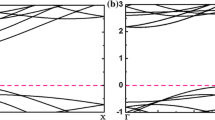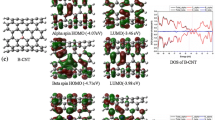Abstract
Interaction of the alkali metals (AMs) like lithium (Li), sodium (Na), and potassium (K) with defective and non-defective (8,0) C3N nanotubes (C3NNT) have been investigated using the first-principles study. In addition to structural properties, we have also studied the electronic properties, charge transfer, and work function of the AM-C3NNT complexes. AMs are adsorbed on hollow sites, regardless of the initial positions. Upon the adsorption of AMs, the structures exhibit semiconducting behavior. Furthermore, interaction of Li atom can be explained by Dewar model, whereas for the other atoms there are different explanations. For all metal adsorbates, the direction of the charge transfer is from adsorbate to adsorbent, because of their high surface reactivity. The results showed that the nanotube with carbon vacancy is the most favorite adsorbent. Our findings also indicated that the enhancement in absolute adsorption energy is in order of Li > K > Na. It is noteworthy that clustering of AM atoms on the nanotubes with and without defects is not expected. It is worthy that C3NNT is a better adsorbent for AM atoms than CNT, graphene, C60, and B80.




Similar content being viewed by others
References
Janiak C, Hoffmann R, Sjovall P, Kasemo B (1993) The potassium promoter function in the oxidation of graphite: an experimental and theoretical study. Langmuir 9(12):3427–3440
Chen P, Wu X, Lin J, Tan K (1999) High H2 uptake by alkali-doped carbon nanotubes under ambient pressure and moderate temperatures. Science 285(5424):91–93
Lan J, Cao D, Wang W, Smit B (2010) Doping of alkali, alkaline-earth, and transition metals in covalent-organic frameworks for enhancing CO2 capture by first-principles calculations and molecular simulations. ACS Nano 4(7):4225–4237
Yang Z, Ni J (2012) Li-doped BC3 sheet for high-capacity hydrogen storage. Appl Phys Lett 100(18):183109
Yoo E, Kim J, Hosono E, H-s Z, Kudo T, Honma I (2008) Large reversible Li storage of graphene nanosheet families for use in rechargeable lithium ion batteries. Nano Lett 8(8):2277–2282
Bruce PG, Freunberger SA, Hardwick LJ, Tarascon J-M (2012) Li-O2 and Li-S batteries with high energy storage. Nat Mater 11(1):19–29
Wang Y, Shao Y, Matson DW, Li J, Lin Y (2010) Nitrogen-doped graphene and its application in electrochemical biosensing. ACS Nano 4(4):1790–1798
Ayala P, Arenal R, Rümmeli M, Rubio A, Pichler T (2010) The doping of carbon nanotubes with nitrogen and their potential applications. Carbon 48(3):575–586
Mabena LF, Ray SS, Mhlanga SD, Coville NJ (2011) Nitrogen-doped carbon nanotubes as a metal catalyst support. Appl Nanosci 1(2):67–77
Maldonado S, Morin S, Stevenson KJ (2006) Structure, composition, and chemical reactivity of carbon nanotubes by selective nitrogen doping. Carbon 44(8):1429–1437
Jalili S, Molani F, Schofield J (2013) Ti-coated BC2N nanotubes as hydrogen storage materials. Can J Chem 91(999):1–7
Pan H, Zhang Y-W, Shenoy VB, Gao H (2011) Metal-functionalized single-walled graphitic carbon nitride nanotubes: a first-principles study on magnetic property. Nanoscale Res Lett 6(1):97
Kong XK, Chen QW, Lun ZY (2014) The influence of N‐doped carbon materials on supported Pd: enhanced hydrogen storage and oxygen reduction performance. ChemPhysChem 15(2):344–350
Reddy ALM, Srivastava A, Gowda SR, Gullapalli H, Dubey M, Ajayan PM (2010) Synthesis of nitrogen-doped graphene films for lithium battery application. ACS Nano 4(11):6337–6342
Bu Y, Chen Z, Yu J, Li W (2012) A novel application of g-C3N4 thin film in photoelectrochemical anticorrosion. Electrochim Acta 88:294–300
Bulusheva L, Okotrub A, Kurenya A, Zhang H, Zhang H, Chen X, Song H (2011) Electrochemical properties of nitrogen-doped carbon nanotube anode in Li-ion batteries. Carbon 49(12):4013–4023
Baughman RH, Zakhidov AA, de Heer WA (2002) Carbon nanotubes—the route toward applications. Science 297(5582):787–792
Azevedo S, Machado M, Kaschny J (2011) Stability and electronic states of NC3 nanoribbons. Appl Phys A 104(1):55–60
Czerw R, Terrones M, Charlier JC, Blase X, Foley B, Kamalakaran R, Grobert N, Terrones H, Tekleab D, Ajayan P (2001) Identification of electron donor states in N-doped carbon nanotubes. Nano Lett 1(9):457–460
Hales J, Barnard AS (2009) Thermodynamic stability and electronic structure of small carbon nitride nanotubes. J Phys Condens Matter 21(14):144203
Jalili S, Molani F, Akhavan M, Schofield J (2014) Role of defects on structural and electronic properties of zigzag C3N nanotubes: a first-principle study. Phys E: Low-dimensional Syst Nanostruct 56:48–54
Sandré É, Pickard CJ, Colliex C (2000) What are the possible structures for CNx compounds? The example of C3N. Chem Phys Lett 325(1):53–60
Kim E, Chen C, Köhler T, Elstner M, Frauenheim T (2001) Theoretical study of a body-centered-tetragonal phase of carbon nitride. Phys Rev B 64(9):094107
Azevedo S, De Paiva R (2006) Structural stability and electronic properties of carbon-boron nitride compounds. EPL (Europhys Lett) 75(1):126
Giannozzi P, Baroni S, Bonini N, Calandra M, Car R, Cavazzoni C, Ceresoli D, Chiarotti GL, Cococcioni M, Dabo I (2009) QUANTUM ESPRESSO: a modular and open-source software project for quantum simulations of materials. J Phys Condens Matter 21(39):395502
Perdew JP, Zunger A (1981) Self-interaction correction to density-functional approximations for many-electron systems. Phys Rev B 23(10):5048
Perdew JP, Burke K, Ernzerhof M (1996) Generalized gradient approximation made simple. Phys Rev Lett 77(18):3865–3868
Vanderbilt D (1990) Soft self-consistent pseudopotentials in a generalized eigenvalue formalism. Phys Rev B 41(11):7892
Monkhorst HJ, Pack JD (1976) Special points for Brillouin-zone integrations. Phys Rev B 13(12):5188–5192
Löwdin PO (1950) On the non‐orthogonality problem connected with the use of atomic wave functions in the theory of molecules and crystals. J Chem Phys 18(3):365–375
Kittel C (2005) Introduction to solid state physics, 8th edn. Wiley, New York
Zhou Z, Gao X, Yan J, Song D, Morinaga M (2004) A first-principles study of lithium absorption in boron-or nitrogen-doped single-walled carbon nanotubes. Carbon 42(12):2677–2682
Chan KT, Neaton J, Cohen ML (2008) First-principles study of metal adatom adsorption on graphene. Phys Rev B 77(23):235430
Sahin H, Peeters FM (2013) Adsorption of alkali, alkaline-earth, and 3d transition metal atoms on silicene. Phys Rev B 87(8):085423
Chandrakumar K, Ghosh SK (2008) Alkali-metal-induced enhancement of hydrogen adsorption in C60 fullerene: an ab initio study. Nano Lett 8(1):13–19
Li Y, Zhou G, Li J, Gu B-L, Duan W (2008) Alkali-metal-doped B80 as high-capacity hydrogen storage media. J Phys Chem C 112(49):19268–19271
Mingos DMP (2001) A historical perspective on Dewar’s landmark contribution to organometallic chemistry. J Organomet Chem 635(1):1–8
Zhou W, Yildirim T, Durgun E, Ciraci S (2007) Hydrogen absorption properties of metal-ethylene complexes. Phys Rev B 76(8):085434
Acknowledgments
Computations were performed on the General Purpose Cluster (GPC) supercomputer at the SciNet High Performance Computing (HPC) Consortium. SciNet is funded by: the Canada Foundation for Innovation under the auspices of Compute Canada; the Government of Ontario; Ontario Research Fund − Research Excellence; and the University of Toronto. Further, we are grateful to Sanandaj Branch, Islamic Azad University Council for the financial support of this research.
Author information
Authors and Affiliations
Corresponding author
Rights and permissions
About this article
Cite this article
Molani, F., Jalili, S. & Schofield, J. Computational study of interaction of alkali metals with C3N nanotubes. J Mol Model 21, 20 (2015). https://doi.org/10.1007/s00894-014-2566-0
Received:
Accepted:
Published:
DOI: https://doi.org/10.1007/s00894-014-2566-0




